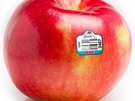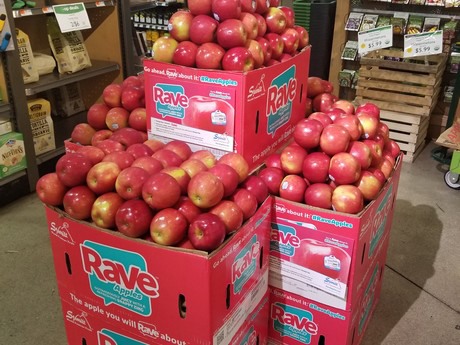 One new variety of apple has already wrapped up picking for the season.
One new variety of apple has already wrapped up picking for the season.
The Rave apple, from Stemilt Growers in Wenatchee, Wa., is an apple bred by David Bedford of the University of Minnesota—the same person behind the Honeycrisp apple. The other part of the apple’s parentage is the MonArk apple.
“The MonArk is an apple out of Arkansas that’s made for that area with severe heat and humidity,” says Stemilt’s Roger Pepperl. While traditionally apples garner their color from fall cold snaps, the Rave is made for the heat and colors in the heat. “So you get a Honeycrisp crunch with tart sweet flavouring and you get color and ripeness super early,” says Pepperl, adding that there are a lot of varieties with partial Honeycrisp parentage coming down the pipe currently.
Arkansas meets Washington
While this is Stemilt’s third year with the apple--which is being grown in Mattawa, Washington, approximately two hours north of the Oregon border because of its warmth and low altitude--it’s the first year with a significant amount of fruit. Picking began in the last week of July for the apple and harvest is already done. “When we pick, we let the bins sit in cold storage for four to five days to let the fruit settle and to let the cells firm up a bit so there wouldn’t be bruising,” says Pepperl. “It’s a traditional method of packing fruit that might be sensitive to bruising.”
It’s a marked difference for the apple category in supplying fresh domestic apples at a time when most of what’s being seen on storage shelves is derived from storage apples or imports even. “But apples, even in the summertime, they are four to five percent of the produce category. There are no fresh apples left so we can be the best thing on a pretty substantial category. People eat them year-round,” says Pepperl.
He does note that eventually as acreage expands into farther north regions, that Stemilt will be able to go longer on apples. “This apple will fill this early period. But we also think people will really love it so why wouldn’t we want to go all the way to Christmas or beyond?” says Stemilt. And as licence owner for the Rave, licenses have been granted to growers in Michigan and New York state already to expand the number of growing regions the apple comes from.

Finding a difference
But how do you get a new apple to stand out in a category filled with…new apples?
Strong packaging for one. “We have fuchsia and teal-colored packaging that’s loud and can have displays built on it. And Rave is just four letters and that’s an advantage, to have a brand that’s a short word,” says Pepperl. The apples, which Stemilt came in with just less than 180,000 cartons this year, have a variety of packaging options which include standard cartons, euro carton store packaging in 4 lb. stand up pouches, 12-pack clamshells, 2 lb. pouch bags and more.
The other part is the marketing strategy. Along with a strong social media push and strategic social media advertising, more unique initiatives include the Ravemobile which is travelling throughout parts of the U.S., beginning in the parent state of Minnesota. “There’s a tasting tent for samples and a porch swing and orchard where you can sit and shoot a picture of yourself,” says Pepperl, adding that it’s also doing grower demonstrations.
Pricing
The Rave is also being priced at a premium rate but perhaps not as premium as it could. “We came out at a price that allowed retailers to go out at $1.99/lb. on ad,” says Pepperl. “That surprised people because I think people thought it would be $2.99/lb. We came out at a lower price point that lowers the barrier for the consumer to try it. And then 10 years from now, the market will bear what it bears based on a solid market.”
For more information:
Roger Pepperl
Stemilt Growers
Tel: +1 (509) 663-1451
[email protected]
https://www.stemilt.com/
